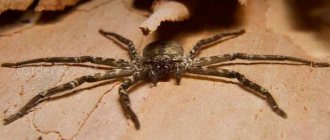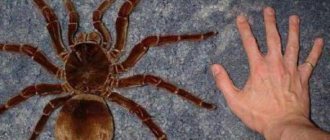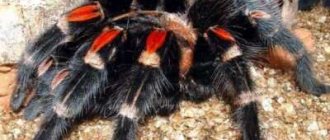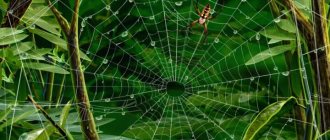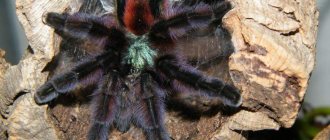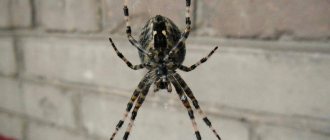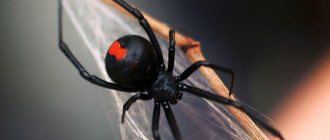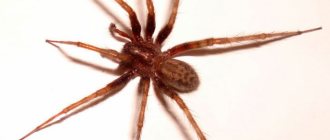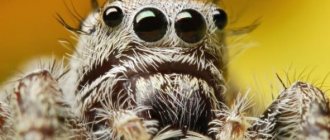Home › Terrariums and inhabitants ›
( 1 ratings, average: 5.00 out of 5)
The Goliath Theraphosa blondi is one of the largest and most magnificent spiders in the world. Its impressive size made it incredibly popular. The Goliath tarantula is stocky, with a wide carapace and thick legs, and a coffee-colored body covered with hairs. The leg span can reach 30.5 cm. Such a huge body does not allow the spider to climb up, so it lives on the ground in burrows.
Goliath is not only great, but also dangerous. This is far from the friendliest creature, it is aggressive and can attack. At the same time, it is very nervous and fast, and can emit a hiss by rubbing its bristles with its legs, which can be heard at a distance of up to 4.5 meters.
The Goliath tarantula prefers solitude and must be kept separately from other spiders. In captivity, goliaths practically do not reproduce, so they come into the terrarium from the wild. To keep them, they need a large room with a deep, moist substrate.
You can observe them at night under red light, when they come to the surface in search of food.
Description of the Goliath tarantula
The largest mygalomorphic spider, Theraphosa blondi, belongs to the large family Theraphosidae (from the suborder Orthognatha), which includes approximately 800 species. The term “tarantula spiders” appeared thanks to Maria Sibylla Merian, a German animal painter who depicted the attack of a huge spider on a hummingbird in a series of her engravings.
Her work "Metamorphosis insectorum Surinamensium" with drawings of an arachnid monster was presented to the public in 1705, but only a century later (in 1804) Theraphosa blondi received a scientific description from the French entomologist Pierre André Latreille.
Appearance
Like other spiders, the body of the goliath tarantula consists of two sections connected by a special tube - the cephalothorax and a complete abdomen. About 20–30% of the volume of the cephalothorax is in the brain. The dorsal shield of the Goliath spider has equal width and length.
The cephalothorax is divided by a groove into two parts, the head and chest, the first being equipped with 2 pairs of limbs. These are chelicerae, consisting of a single thickened segment with a movable claw (under the tip of which there is a hole for removing poison) and a pedipalp, divided into 6 segments.
The mouth, adapted for sucking out soft contents, is located at the top of the tubercle between the chelicerae. Four pairs of legs, each of which is composed of 7 segments, are attached directly to the cephalothorax, behind the pedipalps. The goliath tarantula is discreetly colored, in different shades of brown or gray, but light stripes are noticeable on the legs, separating one segment from the other.
Interesting. Theraphosa blondi is shaggy - long hairs cover not only the limbs, but also the abdomen, the stinging hairs of which are used for protection. The spider scratches them with its hind leg towards the enemy.
The hairs act like tear gas, causing itching, stinging in the eyes, swelling and general weakness. Small animals (rodents) often die, large ones retreat. In humans, hairs can cause allergies, as well as blurred vision if they get into the eyes.
In addition, the hairs, which detect the smallest vibrations in the air/soil, replace the spider (deprived of ears from birth) with the organs of hearing, touch and taste. The spider does not know how to recognize taste with its mouth - the sensitive hairs on its legs “report” on the edibility of the victim. Hairs also become a useful material when weaving webs in a nest.
Goliath spider dimensions
It is believed that an adult male grows up to 4–8.5 cm (excluding limbs), and a female – up to 7–10.4 cm. Chelicerae grow on average to 1.5–2 cm. The leg span in rare cases reaches 30 cm, but more often does not exceed 15–20 cm. Record figures for dimensions belong to females of Theraphosa blondi, whose weight often reaches 150–170 g. It was this specimen with a paw span of 28 cm, caught in Venezuela (1965) that was included in the Guinness Book of Records.
Lifestyle, behavior
Each goliath tarantula has a personal area, the area of which is several meters from the shelter. Spiders do not like to leave the lair far and long, so they try to hunt nearby in order to quickly drag their prey into the house.
Other people's deep burrows often serve as refuge, the owners of which (small rodents) die in fights with goliath spiders, at the same time freeing up living space for them.
The spider covers the entrance to the hole with a web, at the same time tightly enveloping the walls with it. He doesn't really need light, since he doesn't see very well. Females sit in the den for most of the day, leaving it during night hunting or during the breeding season.
When dealing with living creatures, tarantula spiders use poisonous chelicerae (which, by the way, can easily pierce a human palm). Chelicerae are also involved when notifying the enemy of a planned attack: the spider rubs them against each other, producing a distinct hissing sound.
Shedding
Replacing the chitinous cover of the goliath tarantula is so difficult that the spider seems to be reborn. It is not surprising that the age of a spider (when kept at home) is measured in molts. Each subsequent molt gives rise to a new stage of spider life. In preparation for it, spiders even refuse food: young ones begin to starve a week, adults - 1-3 months before the expected molting.
The replacement of the outdated exoskeleton (exuvium) is accompanied by an increase in size by approximately 1.5 times, mainly due to the hard parts of the body, especially the legs. It is they, or rather their scope, that are responsible for the size of a particular individual. The tarantula's abdomen becomes somewhat smaller, gaining weight and filling between molts (during the same interval, the stinging hairs growing on the abdomen fall out).
Fact. Young Theraphosa blondi molt almost every month. As they grow older, the intervals between moults become longer and longer. Sexually mature female goliaths shed their old coat about once a year.
Before molting, the spider is always darker, has a densely stuffed abdomen with completely bald areas where the hairs are combed off, and relatively small overall dimensions. Having emerged from molting, the goliath not only grows larger, but also becomes lighter, the abdomen noticeably falls off, but new stinging hairs appear on it.
Liberation from the previous cover usually occurs on the back, often with difficulties when the spider cannot extend 1-2 legs/pedipalps. In this case, the tarantula discards them: over the next 3–4 molts, the limbs are restored. On the skin shed by the female, an impression of her reproductive organs remains, which makes it easy to identify the sex of the tarantula, especially at an early age.
How long do goliaths live?
Tarantulas, and Goliath spiders are no exception, live longer than other terrestrial arthropods, however, their life expectancy depends on gender - females stay in this world longer. In addition, in artificial conditions, the lifespan of Theraphosa blondi is determined by such adjustable factors as temperature/humidity in the terrarium and the availability of food.
Important. The poorer the diet and the colder (moderately!) the atmosphere, the slower the tarantula grows and develops. His metabolic processes are inhibited and, as a result, the aging of the body.
Arachnologists have not yet come to a consensus on the lifespan of Theraphosa blondi, settling on figures of 3–10 years, although there is information about 20- and even 30-year-old centenarians of this species.
Sexual dimorphism
The difference between the sexes, as we found out, is manifested in the lifespan of goliaths: male individuals (that have reached fertility) in most cases do not molt and die within a few months after mating. Females are many times longer than males in terms of duration of earthly existence, and also look more impressive and heavier.
Sexual dimorphism of the Goliath spider is noted not only in size, but also in secondary sexual characteristics, characteristic exclusively of sexually mature males:
- “bulbs” at the tips of the palps, necessary for transporting sperm to the female;
- "spur" or tiny spines on the third segment of the third paw (tibial).
The best indicator of a female's puberty is her behavior when she is attracted to an individual of the opposite sex.
Return to content
Links[edit]
- ↑
World's Largest Spider Face-Off - See which bug wins here. Archived October 23, 2014, at the Wayback Machine. - Herzig, Volker; King, Glenn F. (2013). "Neurotoxic mechanism of action of venoms of the spider family Theraphosidae". In Nentwig, Wolfgang (ed.). Ecophysiology of the Spider
. Springer. item 203. ISBN. 978-3-642-33989-9. - "Goliath Birdeater". Animals
. 2018-12-17. Retrieved December 4, 2022. - ↑
Goliath Bird-Eating Spider, Archived April 16, 2016, at the Wayback Machine, Archive. - "Goliath Bird-Eating Spider". Spider Worlds
. Retrieved November 11, 2022. - "Goliath bird eats spider". Biomes of the Blue Planet
. 2003. Archived from the original on July 19, 2022. Retrieved November 11, 2022. - Perez-Miles, Fernando; Montes de Oca, Laura; Postiglioni, Rodrigo; Costa, Fernando G. (December 2005). "Stridulatory setae of Acanthoscurria suina (Araneae, Theraphosidae) and their possible role in sexual communication: an experimental approach" (PDF). Iheringia, Serie Zoologia
.
95
(4):365–371. DOI: 10.1590/S0073-47212005000400004. - ^ ab Lewis, Tanya (October 18, 2016). "Goliath Birdeater: Images of a Colossal Spider". Living Science
. Retrieved February 20, 2022. - ↑
Lewis, Tanya (October 17, 2014).
"Meet Goliath: Puppy-Sized Spider Scientist Surprises in Rainforest". Living Science
. Archived from the original on November 24, 2022. - National Geographic
- Menin, Marcelo; Rodriguez, Domingos De Jesus; de Azevedo, Clarissa Salette (October 2005). "Predation of spiders (Arachnida, Araneae) on amphibians in the Neotropical region". Phyllomedusa
.
4
(1):39–47. DOI: 10.11606/issn.2316-9079.v4i1p39-47. ISSN 1519-1397. - Striffler, Boris Fedorovich (November 2005). "Life history of Goliath Birdeaters - Theraphosa apophysis and Theraphosa blondi (Araneae, Theraphosidae, Theraphosinae)" (PDF). Journal of the British Tarantula Society
.
21
(1): 26–33. ISSN 0962-449X. Archived from the original (PDF) on December 6, 2013. Retrieved September 10, 2013. - Dell'Amore, Christina (20 October 2014). "Puppy-sized tarantula found: World's largest spider explained". National Geographic Blog
. Archived from the original on December 15, 2022.
Goliath tarantula diet
Spiders of this species are capable of starving for months without any health consequences, but, on the other hand, they are distinguished by an excellent appetite, especially noticeable in captivity.
Fact. Theraphosa blondi is recognized as an obligate predator, but like related species it does not justify the name of the family (tarantula), since it is not aimed at the constant consumption of bird meat.
In addition to birds, the diet of the goliath tarantula includes:
- small arachnids;
- cockroaches and flies;
- bloodworms;
- small rodents;
- lizards and snakes;
- toads and frogs;
- fish and more.
Theraphosa blondi lies in wait for its prey in ambush (without using a web): at this time it is absolutely motionless and remains imperturbable for hours. The spider's activity is inversely proportional to its satiety - a full-fed female does not leave the den for months.
Seeing a suitable object, the goliath pounces on it and bites it, injecting poison with a paralyzing effect. The victim cannot move, and the spider fills it with digestive juice, which liquefies the insides. Having softened them to the desired condition, the spider sucks out the liquid, but does not touch the skin, chitinous cover and bones.
In captivity, adult tarantulas are given both live food and killed mice/frogs, as well as slices of meat. For young individuals (up to 4–5 moults), it is important to choose the right food insects: they should not exceed 1/2 of the spider’s abdomen. Larger insects can frighten the goliath, causing stress and refusal of food.
Attention. The venom of the goliath tarantula is not dangerous to a healthy person and is comparable in consequences to that of a bee: the bite site is slightly sore and swollen. Fever, acute pain, cramps and an allergic reaction are somewhat less common.
Pets, such as rats and cats, die from the bite of Theraphosa blondi, but no fatalities have been recorded in humans. However, these spiders should not be kept in families with small children or people prone to allergies.
Return to content
Keeping a spider in captivity
The spider can be kept in captivity, but it is necessary to provide it with suitable conditions. This makes the spider quite difficult to keep, so they do not live long in captivity. Also, the species can be quite aggressive, which will cause problems for an inexperienced owner.
You need a spacious spider bed with a large amount of soil (coconut substrate) to build a burrow, or install a shelter, such as a large coconut shell.
It is important to constantly maintain high humidity from 80 to 95%, the required temperature is from 25 to 30°C.
You can feed the spider with large insects and small rodents. Young spiders can be fed several times a week; adult spiders need to be fed once a week. To avoid mold, there must be mandatory ventilation in the spider plant.
The danger for humans when keeping this species is represented by its hairs, which sooner or later will cause various allergic and irritating reactions in the owner, since they will enter the room through the ventilation of the spider, it is necessary to carefully consider the choice of place to place the spider.
Goliath spider hairs
Reproduction and offspring
Goliath spiders breed all year round. The male, attracting the attention of the female, beats a drum roll near her den: if the partner is ready, she allows mating. The male holds her chelicerae with his tibial hooks, transferring the seed on the pedipalps inside the female.
Having completed intercourse, the partner runs away, since the female usually strives to eat him. A few months later, she weaves a cocoon containing from 50 to 2 thousand eggs. The mother nervously guards the cocoon for 6–7 weeks, carrying and turning it over until the nymphs (newborn spiders) hatch. After 2 molts, the nymphma becomes a larva - a full-fledged young spider. Males become fertile by 1.5 years, females no earlier than 2–2.5 years.
Return to content
External links [edit]
| Wikimedia Commons has media related to Theraphosa blondi . |
| Wikispecies has information about Theraphosa blondi . |
- Caring for Your Goliath Bird Eating a Tarantula at the Wayback Machine (archived October 31, 2013)
- Video of the Goliath tarantula at National Geographic
| Taxon identifiers |
|
| Authoritative control |
|
Natural enemies
Theraphosa blondi, despite its inherent toxicity, has quite a few of them. Large predators are not particularly interested in the goliath, but he and his offspring often become the gastronomic target of the following hunters:
- centipedes, for example, Scolopendra gigantea (40 cm in length);
- scorpions from the genera Liocheles, Hemilychas, Isometrus, Lychas, Urodacus (partially) and Isometroides;
- large spiders of the genus Lycosidae;
- ants;
- aha toad, or Bufo marinus.
The latter, by the way, has adapted to climb into holes where females and children are located in order to methodically devour newborns.
Goliath tarantulas also die under the hooves of heavy collared peccaries.
Return to content
Lifestyle
The Goliath tarantula leads a solitary and nocturnal lifestyle. It is a terrestrial spider, since due to its large weight it does not climb trees.
On this topic, you may be interested in: Wasp spider, description, where it lives, why it is dangerous
Despite the fact that the spider has eight eyes, it has poor vision, no ears and does not perceive smells. Its olfactory organs are its hairs, which cover its entire body. Thanks to vibrations from the hairs, he manages to successfully hunt and avoid danger. Thanks to them, he receives information about the size of prey nearby.
This species, unlike most spiders, can make hissing sounds when danger arises. This hissing can be heard at a distance of up to 15 meters.
In case of danger, the spider begins to hiss loudly, rub the hair on its body with its hind legs, throwing it into the air; if this does not help, it stands on its hind legs and shows its fangs.
Poisonous or not
All varieties of tarantula spiders are poisonous in their own way, and if we are talking about a non-poisonous representative, then most likely we mean the low toxicity of its poison. A bite from this arthropod cannot cause much harm to an adult and healthy person, but small pets can die. In addition, goliath is considered dangerous for small children and people suffering from allergic reactions to the toxin released with the poison.
Important! Not in all cases, when a spider bites, poison is released, but it is stored on the arthropod’s legs, which is why any contact with it must be done with gloves. Allergies usually result in severe itching, burning and general weakness.
Choosing and arranging a home
The first thing you should consider before buying a goliath is arranging a separate home for it, and if you plan to have a pair, then there should be two terrariums.
Video: setting up a terrarium for a tarantula spider
Tarantula spiders should not be kept in groups as they are aggressive towards each other. The lifespan of females is longer, but males have brighter colors, due to which they are chosen more often.
Whatever gender you prefer, the requirements for the terrarium remain the same:
- it must be made of durable plexiglass;
- the dimensions of the tank should be several times greater than the parameters of its inhabitant (including the legs), and it is better that these are cube-shaped containers: for example, 20x20x20 or 30x30x30 cm;
- the lid of the terrarium must have ventilation holes with a diameter of 2–3 mm and adhere well to the tank (so that the spider cannot escape);
- When making your own, it is advisable to use silicone sealant.
It is worth paying attention to the arrangement of the internal space of the tank. If you are going to purchase terrestrial inhabitants that settle in burrows, you will have to pour a 15-centimeter layer of soil into the terrarium, which will provide the spider with conditions as close as possible to natural ones.
You can cover the bottom with less soil, but then you will have to place additional objects in the terrarium to serve as shelter for the goliath. These could be parts of a pot for a flowerpot, fancy driftwood, or special decorative elements purchased at a pet store. Coconut filler (crushed coconut bark), which is sold in the same pet store, is ideal for the role of substrate.
The necessary conditions
The tarantula spider is a tropical resident, which means that at home it needs to create appropriate conditions that are as close as possible to its natural habitat.
Important! If possible, it is worth purchasing a special device from a hardware store that will measure the temperature and humidity in the tank with the spider. This way you can timely adjust the indicators to the required values.
Taking this into account, we need to focus on the following indicators:
- air humidity in the terrarium is 75–90% (if necessary, you can wet the inner walls of the tank with a spray bottle, be sure to install drinkers with a large area inside; reduced air humidity causes problems with molting);
- temperature - the ideal option is 28–30°C, but lower values within 24–25°C are also acceptable (if the room temperature remains stably low, you will have to use a heater, not forgetting that sudden temperature changes with changes of 7–10 °C can kill pets);
- lighting can be minimal, and it is better to place the terrarium itself in a shaded place (goliath is a nocturnal inhabitant and will experience stress in bright light).
Feeding
You already know what the tarantula spider eats in its natural habitat, but at home it is very difficult to choose its usual diet. You can replace some of its components with ready-made food from a pet store, and in the summer you can supplement the menu with caterpillars, flies and grasshoppers.
Among the products in the pet store you should pay attention to:
- frogs;
- mealworms;
- locusts;
- small reptiles;
- Zophobus;
- marble cockroaches (one of the goliath’s favorite delicacies).
It is better not to give meat and meat products familiar to the human table, as this can lead to indigestion and even the death of the pet.
We recommend that you familiarize yourself with the features of keeping such spiders as the wolf spider, tarantula and black widow.
The water in the terrarium is changed every 1-2 days, and it is advisable to remove any remaining food immediately after the spider eats. One hearty breakfast can last a goliath for several days or even a week; However, young individuals cannot be fed less than once every 2–3 days.
Cleaning the terrarium
In order for the tarantula to always remain healthy and in good spirits, it simply needs to ensure cleanliness in the terrarium. Standard tank cleaning involves removing food debris and spider waste products, but always using long tongs and protective gloves.
This is especially true in cases where the goliath is not accustomed to handling and has a bad character. Small cleaning can be done once a week, but every 3-4 months you will have to completely clean the terrarium, replacing the bedding layer.
Important! When contacting any surfaces on which traces of tarantula venom may remain, it is advisable to use gloves. This will help prevent itching and burning of the skin due to a local allergic reaction.
During cleaning, the spider should be transplanted into a temporary terrarium or other small tank with transparent walls.
So, keeping a tarantula spider at home is quite possible, but very troublesome. Some owners talk about the possibility of training a goliath, but in any case, do not forget that this is a wild animal and its behavior can be unpredictable. Stay vigilant and always follow safety rules when interacting with such a pet.
Danger to humans
The goliath tarantula is not distinguished by aggressive behavior, it does not rush to attack at the sight of a person, but it betrays its unfriendly attitude by hissing. The bite is inflicted solely for the purpose of self-defense. In terms of the strength of the painful sensations, it is compared to a wasp or hornet. A spider bite is not life-threatening, but causes some discomfort.
Redness, swelling, and pain appear at the site of the bite. In young children, people with weak immunity, and allergy sufferers, there is a deterioration in general health - dizziness, weakness, headache, nausea, vomiting, fever. The condition returns to normal after a few days; antihistamines are taken to speed up the therapeutic effect.
Attention - shedding!
Spiders cannot do without it. At a young age, the exoskeleton changes frequently; adults molt about once a year. During the molting process, spiders hardly move or eat. A day before the change of “skin” they generally freeze, lying on their back. No need to worry and check if your pet is alive, just wait. When the old “clothes” come off, there will be new, soft ones underneath; At the same time, the spider becomes completely defenseless. Normal humidity at such a moment is vitally important; if the air is too dry, the animal dies. It will not be eaten until the cover hardens, which lasts several days.
Keeping large spiders, as we see, is a troublesome task. However, they are interesting to watch. And few of your friends can boast of such pets. And if you overcome your prejudice, you will see how beautiful the Goliath tarantula is (photo above).
Sources
- https://animalsinfo.ru/%D0%BF%D1%82%D0%B8%D1%86%D0%B5%D0%B5%D0%B4-%D0%B3%D0%BE%D0%BB% D0%B8%D0%B0%D1%84-%D0%BB%D0%B0%D1%82-theraphosa-blondi/
- https://apest.ru/pauki/vidy-paukov/pauk-goliaf/
- https://top-cat.ru/goliaf-pticeed-razmer/
- https://aquamir-za-steklom.ru/terrariumy/goliaf-pauk-pticeed.html
- https://homychok.ru/pauk-ptitseed-goliath-opisanie-vida-soderzhanie/
- https://parazitdoma.ru/drugie-parazity/ptitseed-goliaf
- https://ardo-dez.ru/opasnye/samye-bolshie-pauki-pticeedy-2.html
- https://zveryatnik.ru/pauk-pticeed/kak-soderzhat-ptitseeda-goliafa.html
- https://pets2.me/bok/1739-pauk-goliaf-opisanie-osobennosti-stroeniya-chem-kormit-v-domashnih-usloviyah.html
- https://FB.ru/article/162950/pauk-ptitseed-goliath-soderjanie-i-uhod-foto
[collapse]
